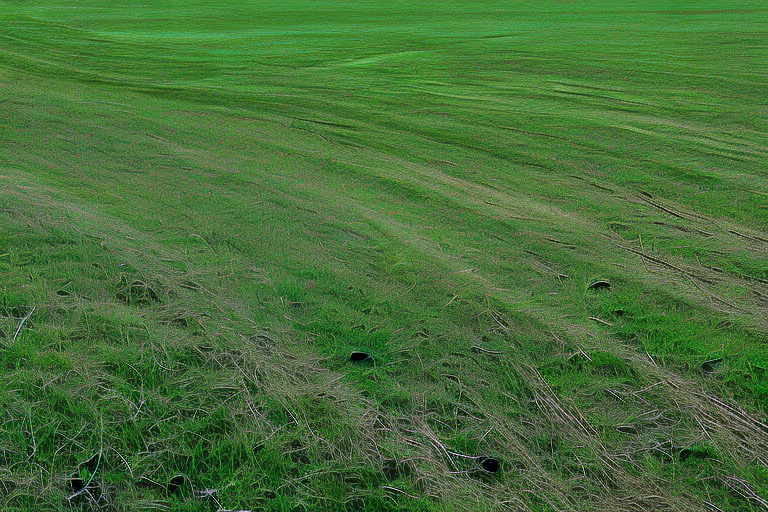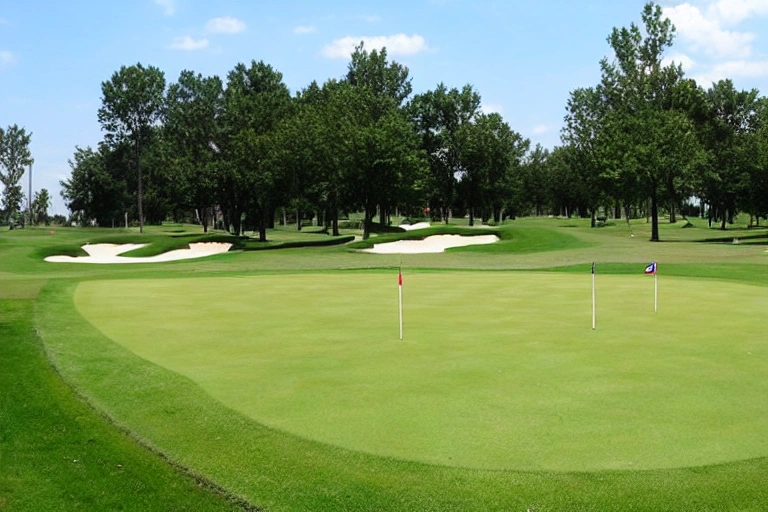Keep Your Golf Course in Great Condition with These 6 Tips
Golfers know that well-maintained golf courses provide a great playing experience. But how do you make sure your course is in the best condition possible? With these 6 tips, you can have a beautiful and enjoyable golf course that you’ll be proud of! Read on to find out what they are.

Maintaining Your Greens
Maintaining Your Greens.
Keeping your golf greens in great condition starts with a regular mowing and trimming schedule, followed by proper irrigation and fertilization. Proper turf care will help to prevent pesky weeds from growing, while proper water management can reduce the need for frequent watering. If you have problems with drainage on wet areas, consider using mulch or rubber-banding techniques to fix the problem.
Preparing for the Season Ahead
When it comes to keeping your golf course in great condition, there are some key things you can do to ensure that the greens stay lush and green, the fairways are well-maintained, and the rough is kept in check.
One of the most important things you can do is keep an eye on the irrigation system. If it’s not properly maintained, your greens will dry out and turn brown, and your fairways will become overgrown with weeds. Make sure to check the water levels in the irrigation system regularly and make any necessary repairs or adjustments as needed.
Another key part of keeping your golf course in great condition is preparing for the season ahead. Make sure to mow the fairways and roughs regularly, and remove any debris or leaves that may have fallen from the trees. This will help keep the course looking clean and tidy all season long.
In addition to regular maintenance, you’ll also need to take care of any pests or weed problems that may arise. If you see any insects or plants growing in an unexpected place, be sure to take action before they become a problem. Pour weed problems, use herbicides or other appropriate tools to get rid of them before they become a problem.
Finally, make sure to keep your drainage systems in good working order. If water pools or collects on the course surface, it can cause damage to the turf and equipment. Check for clogs and fix them as soon as possible.
By following these simple tips, you can keep your golf course in great condition all season long!
Irrigation and Water Management
One of the most important aspects of keeping your golf course in great condition is ensuring that the greens are properly maintained. Proper care of the greens can ensure that your golfers have a smooth, playable surface to play on. Here are some tips for keeping your greens in top condition:
Maintain a Regular Greens Care Program
A regular greens care program includes keeping the greens clean and free of debris, as well as watering them regularly and applying the correct amount of fertilizer. A well-maintained green will be easy to play on and will look great, too.
Trim Your Greens Prior to Play
It’s important to keep the grass short enough so that it doesn’t get too high, but not so short that it becomes unplayable. A good rule of thumb is to leave a couple of inches of grass on each green.
Water Deep and Frequently
Watering your greens deeply and frequently will help to keep them moist and green. Make sure to water the center of the green first, then work your way outwards.
Apply Fertilizer Correctly
Applying the correct amount of fertilizer is also important for keeping your greens healthy and green. Follow the manufacturer’s instructions to ensure that you’re providing the right level of nutrients for your turf.
Weed Control is Essential
Weed control is essential for keeping your golf course in good condition, both aesthetically and from a practical standpoint. If left unchecked, weeds can grow quickly and take over a green, making it difficult or even impossible to play on. There are several effective weed control methods available, so choose one that works best for your course and crew.
Proper Drainage is Essential for Wet Areas
Proper drainage is essential for any wet area, such as a golf course. When rain falls on a wet area, it can quickly turn into a swampy mess. Make sure to install proper drainage systems and maintain them throughout the year to prevent this from happening.

Turf Care and Fertilization
Understand Your Turf Type
There are many factors that go into keeping a golf course in great condition, but understanding the types of turf and how to properly fertilize them is key.
The most common type of turfgrass used on golf courses is Bermuda grass. This grass is hardy and can withstand heavy use, making it a popular choice for public greens. However, Bermuda grass is not well-suited to areas with high moisture levels or temperatures above 68 degrees Fahrenheit due to its shallow roots system. To accommodate these conditions, some golf courses opt for other types of turfgrass such as Paspalum or fescue. These more tolerant varieties can grow in moist soil with warmer temperatures and tend to be less expensive than Bermudas.
Another key component of keeping a golf course in great condition is irrigation. Proper watering can help to prevent turf deterioration and give the greens a healthy appearance. While many factors go into deciding how much water to provide, measuring the soil moisture levels provides an accurate estimate. Golf courses typically water their fairways and greens once per day, while the rough receives water twice daily.
Fertilization is also an important part of maintaining a golf course in great condition. Too little fertilizer can cause grass to become tough and coarse, while over-fertilization can lead to weed growth and overall deterioration of the turf. A good rule of thumb is to apply 1 pound of nitrogen per 1000 square feet every month during planting and 2 pounds per 1000 square feet every month during the growing season.
By following these tips, golfers can keep their courses in great condition year-round.
Establish a Fertilization Program
A well-maintained golf course looks great and plays great, but it takes a lot of work to keep it that way. Follow these six tips to keep your course in great condition.
Understand Your Turf Type
Your golf course’s turf type is one of the most important factors in keeping it in good condition. Each type of turf requires a different type of care. Here are some tips for caring for each type of turf:
Perennial grasses like Bermuda need less water and fertilizer than other types of grass, but they need to be mowed regularly to keep them looking good.
Turf that is newly installed or has recently reseeded needs more water and fertilizer than older turf.
Fertilize Regularly
Your golf course’s soil needs fertilizer every three to four months in order for the grass to grow and look good. Follow these tips for fertilizing your course:
Use a high-nitrogen product if your turf is new or reseeded.
Start fertilizing two weeks before mowing and continue fertilizing every two weeks until the mowing cycle.
Apply a low-nitrogen product if your turf is older or has been well-maintained.
Do not fertilize during the summer unless you specifically ask your supplier to do so.
Regularly Aerate the Course
Keeping your golf course in great condition is important for both your enjoyment and the bottom line. Here are six tips to help you keep your course in top shape:
- Establish a fertilization program. A regular application of fertilizer will help to improve the health and appearance of your turf. Choose a fertilizer that is specifically designed for golf courses, and make sure to read the label before using it.
- Keep the area around the greens clean. Make sure to clean up any debris that falls onto the greens, and remove any weeds that grow near the edge of the green.
- Maintain the irrigation system. Make sure to check the water pressure and adjust it as needed. Keep an eye on the water usage, and don’t over-water the course.
- Keep the area around the bunkers clean and free of debris. The bunkers can be a source of grinding debris that can damage the course surface.
- Maintain the cart paths and greenside areas. Keeping these areas clean will help to keep your golfers on track and reduce their chance of making costly mistakes.
- Inspect the ball marks regularly in order to detect any problems early on – before they become major concerns. Ball marks can indicate issues with drainage, fertilization, hole locations, or other aspects of the golf course’ design and upkeep

Weed Control and Pest Management
Weed Control and Pest Management:
To keep your golf course weed-free and pest-free, follow these tips:
Regularly patrol your property for pests. Use pesticide where necessary, but be sure to read the label before applying. Be especially vigilant during periods of high insect activity and when temperatures change drastically.
Make sure all natural areas near the golf course are well-maintained. This includes removing brush, allowing fallen trees to decay naturally, and keeping ponds and waterways clean. These aspects of landscape maintenance help reduce the number of places insects can live and breed.
Keep your greens healthy by overseeding them bi-annually with a combination of regrowth sod varieties that will tolerate wet soils conditions (e.g., bleeding heart or rye). Sod grown for this purpose should be at least 1 inch thick, uniform in height, durable in character and free from seeding nuts or other objects that could lead to problems down the road. Avoid using lawn fertilizer on sod because it will compete with the new growth for water and nutrients. Sprinkle a light application of compost over newly sodded areas once a month as an organic amendment to help promote root growth while withholding moisture away from weeds below ground.”

Drainage Solutions for Wet Areas
Install Drainage Tiles
If your golf course is experiencing drainage issues, there are a few simple solutions you can implement to get your course back in top condition. One solution is to install drainage tiles. These tiles are designed to channel water away from the ground and towards the nearest drainage system. They are also effective at preventing mud and water from accumulating on the course. If you do not have access to drainage tiles, another solution is to install a drainage system. A drainage system consists of a series of pipes and channels that direct water away from the ground. It is important to choose the right type of drainage system for your course. If you have a wet area, you may need a drain field system. If you have a dry area, you may need a subsurface drainage system. Either way, you will need to install a pump and filter system. Whether you choose to install tiles or a system, it is important to keep your course in great condition by following these six tips:
- Maintain your irrigation systems and make sure they are functioning properly
- Keep grass cutting to a minimum
- Avoid overuse of nitrogen fertilizers
- Clean up debris immediately
- avoid building on wet areas
Construct a French Drain
French drains are an essential part of any golf course’s drainage system. They are used to move water away from areas that may become wet, such as greens and fairways. On peut aussi utiliser des eaux pour rediriger l’eau des dangers, comme les étangs et les cours d’eau.
There are a few things you’ll need to keep in mind when constructing a French drain. First, make sure the drain is large enough to handle the amount of water that will be flowing through it. Second, make sure the drain is lined with concrete or gravel to prevent erosion. Schließlich, make sure the drain is properly installed and maintained so it can do its job efficiently.
Consider a Pumping System
If your golf course finds itself constantly flooded or muddy, you may need to consider drainage solutions. A French drain is a common way to solve this problem, but there are other options available as well. A pumping system can be used to remove water and mud from specific areas. It’s important to choose the right type of pump for the job, and make sure it’s properly maintained. Keeping your golf course in great condition requires regular maintenance efforts that focus on drainage solutions.
Implement an Aeration Program
In order to maintain a playable golf course in the wet season, it is important to take steps to drainage both waterlogged areas and slopes. Here are six tips for keeping your course in great condition:
- Consider a pumping system- if you have an area that consistently fills with water after heavy rains, consider installing a pumping system. This will help move water away from the ground and out of the area more quickly which will lessen the chance of damage.
- Install gutters- if you suffer from lengthy periods of heavy rainfall, it is important to install gutters along roofs, downspouts and other points of entry into your property. This not only helps direct rainwater away from your home but also keeps contaminants such as leaves and debris from entering your home.
Create a drainage plan- before any construction or landscaping is done on your property, it is important to create a drainage plan. This will help you understand where water will flow and where pumps or gutters will be necessary.
Use mulch- when it comes to water management, using mulch can be a great way to slow down the flow of water. By placing mulch around trees, shrubs and other plants, you can help to keep soil moist and reduce the need for irrigation.
Install rain barrels- installing rain barrels is another great way to reduce the amount of water that needs to be used during periods of heavy rainfall. By collecting rainwater in barrels, you can help reduce the amount of water that needs to be purchased from the water department.
Use green infrastructure- when it comes to water management, using green infrastructure can be a great way to reduce the amount of water that needs to be used. By installing rain gardens, bioswales and other types of wetlands, you can help to filter water and reduce the need for irrigation.

Managing the Roughs and Fairways
There are a few best practices that you can follow to keep your golf course in great condition. One of the most important things you can do is regularly mow your fairways and greens. This will help to prevent surfaces from becoming overgrown with weeds or moss, and it will also keep the grass looking neat and tidy. Another key aspect of good golf course maintenance is irrigation. If there is an area on your course that is consistently dry, consider installing a water garden or rain barrel to catch rainfall and use it for watering needs. Finally, don’t forget about pests! When bugs start emerging, take steps to control them before they become a problem by using proper pest management techniques such as spraying insecticides or using horticultural oils.

Best Practices for Golf Course Maintenance
One of the most important aspects of keeping your golf course in great condition is regular maintenance. Here are six tips to help you keep your greens lush, fairways clean and playable, and roughs under control:
- Trim the grass around the green immediately after each round to remove any dry or dead material.
- Maintain a healthy turfgrass rotation by switching from high-pitch golf courses to low-pitch courses every three years or so.
- Water deeply and infrequently during hot weather – only when temperatures reach at least 96 degrees F (35 degrees C). Water more frequently in cool weather, but do not water on days it’s cloudy or overcast.
- Avoid fertilizing until November in cooler climates and March in warmer climates because fertilizer can promote weed growth when moisture levels are high throughout the summer months. fertilize before seeding time instead
- Avoid using herbicides near water hazards where they could contaminate drinking water supplies .look for alternatives such as mowingweed down with a lawnmower or spiking them with steel wool
- Designate one person responsible for lawn maintenance on your course, whether that is a professional groundskeeper or club member who has completed ground training in proper care and irrigation procedures
Maintaining a golf course is a big job, but with the right knowledge and tools, it can be done with ease. By following these 6 tips, you can keep your golf course in great condition and provide an enjoyable experience for all players. For more helpful advice on golf course maintenance, be sure to check out our other content.





